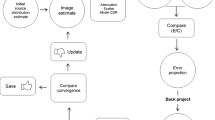Abstract
Dual-isotope studies with technetium-99m and iodine-123 may be useful for various organs, including brain and myocardium. For the images obtained with each of the tracers to be comparable, it is important that activity ratios (activity in one part of the image/reference activity in the image) are preserved by the imaging method. We have used a Rollo phantom to study how collimator response affects such ratios. All investigations were performed with123I(p,5n) and on a Siemens Orbiter 3700 camera fitted with either a low-energy high-resolution (LEHR) or a medium-energy (ME) collimator. Images were made of a Rollo phantom filled with an aqueous solution of either99Tc or123I, and placed on the collimator surface with 8 cm of methyl-methacrylate interposed. Count densities were measured in ROIs drawn in each cell of the phantom, and normalised to the maximal ROI value in the image. The mean square error (MSE) was used to assess how well the ratios of count densities approximated the known activity ratios based on the dimensions of the cells of the phantom. For99mTc, regardless of the collimator used, the count density ratios approximated the activity ratios fairly well (LEHR: MSE=0.008; ME: MSE=0.020). For123I, count density ratios obtained with the LEHR were consistently higher than activity ratios (MSE=0.235), whereas the differences between the measured and the theoretical values were less with the ME collimator (MSE=0.013). Contrast fidelity of the123I images obtained with the LEHR collimator could be improved with Jaszczak scatter correction withk=1, but this led to unfavourable signal-to-noise ratios. For sequential99mTc/123I studies with extended sources, ME is to be preferred because of its higher contrast accuracy. Spatial resolution is less for the ME than for the LEHR collimator (FWHM with scatter: LEHR/99mTc=6.9 mm, LEHR/123I=7.4 mm, ME/99mTc=10.1 mm, ME/123I=11.1 mm), but remains similar for both tracers when the ME is used.
Similar content being viewed by others
References
Devous MD, Payne JK, Lowe JL. Dual-isotope brain SPECT imaging with technetium-99m and iodine-123: clinical validation using xenon-133 SPECT.J Nucl Med 1992; 33: 1919–1924.
Franken PR, De Geeter F, Dendale P, Demoor D, Block P, Bossuyt A. Abnormal free fatty acid uptake in subacute myocardial infarction after coronary thrombolysis: correlation with wall motion and inotropic reserve.J Nucl Med 1994; 35: 1758–1765.
Macey DJ, DeNardo GL, DeNardo S, Hines HH. Comparison of low- and medium-energy collimators for SPECT imaging with iodine-123-labelled antibodies.J Nucl Med 1986; 27: 1467–1474.
Devous MD, Lowe JL, Payne JK. Dual-isotope brain SPECT imaging with technetium-99m and iodine-123: validation by phantom studies.J Nucl Med 1992; 33: 2030–2035.
Ivanovic M, Weber DA, Loncaric S, Franceschi D. Feasibility of dual radionuclide brain imaging with I-123 and Tc-99m.Med Phys 1994; 21: 667–674.
Gilland DR, Jaszczak RJ, Turkington TG, Greer KL, Coleman RE. Volume and activity quantitation with iodine-123 SPECT.J Nucl Med 1994; 35: 1707–1713.
Sorenson JA, Phelps ME. Image quality in nuclear medicine. In: Sorenson JA, Phelps ME.Physics in nuclear medicine, 2nd edn. Orlando: Grune and Stratton; 1987: 362–390.
Jaszczak RJ, Greer KL, Floyd CE Jr., Harris CC, Coleman RE. Improved SPECT quantification using compensation for scattered photons.J Nucl Med 1984; 25: 893–900.
Polak JF, English RJ, Holman BL. Performance of collimators used for tomographic imaging of I-123 contaminated with I-124.J Nucl Med 1983; 24: 1065–1069.
Gilland DR, Jaszczak RJ, Greer KL, Coleman RE. Quantitative SPECT reconstruction of iodine-123 data.J Nucl Med 1991; 32: 527–533.
Koral KF, Swailem FM, Buchbinder S, Clinthorne NH, Rogers WL, Tsui BMW. SPECT dual-energy-window Compton correction: scatter multiplier required for quantification.J Nucl Med 1990; 31: 90–98.
Author information
Authors and Affiliations
Rights and permissions
About this article
Cite this article
De Geeter, F., Franken, P.R., Defrise, M. et al. Optimal collimator choice for sequential iodine-123 and technetium-99m imaging. Eur J Nucl Med 23, 768–774 (1996). https://doi.org/10.1007/BF00843705
Received:
Revised:
Issue Date:
DOI: https://doi.org/10.1007/BF00843705




